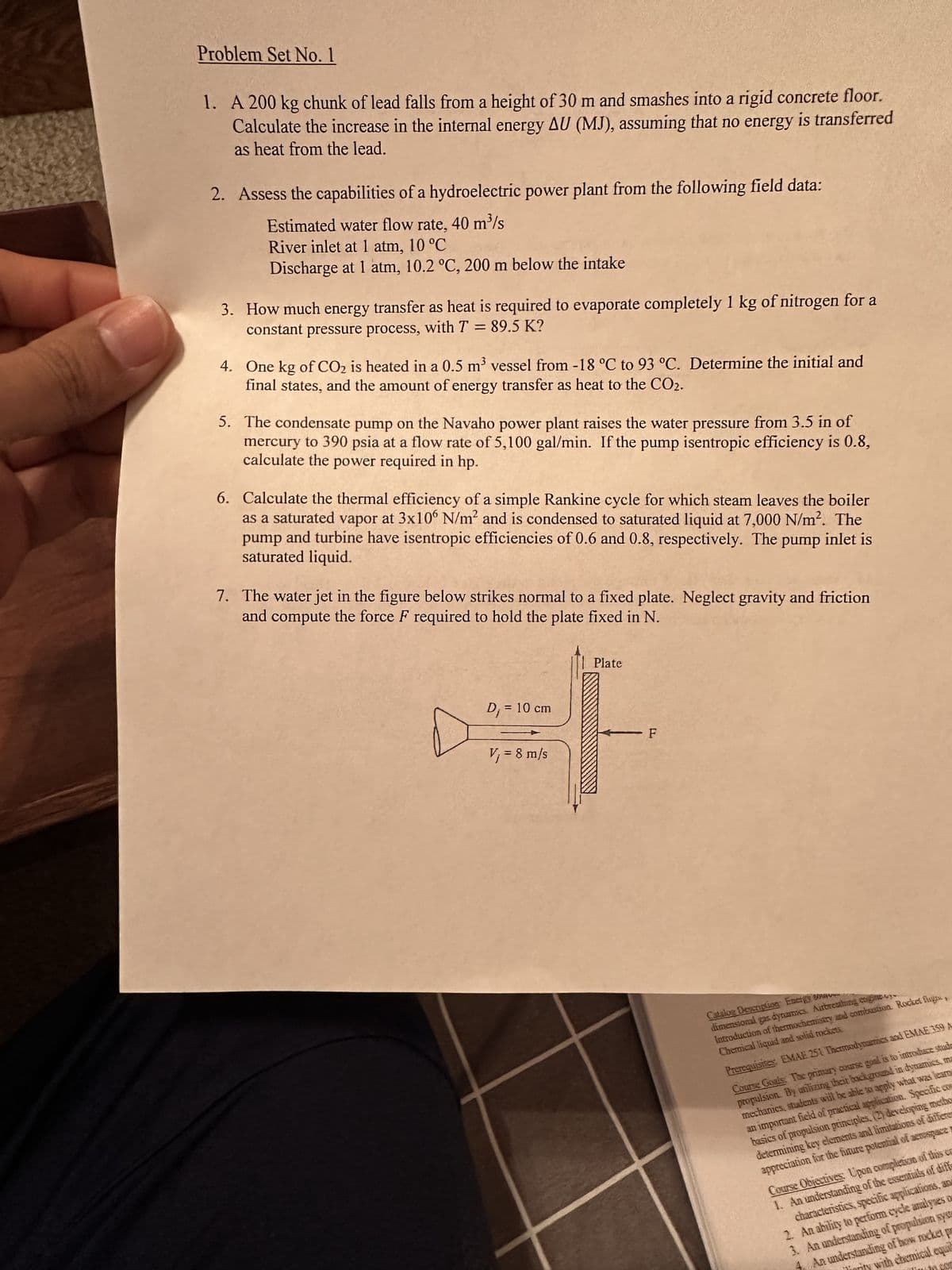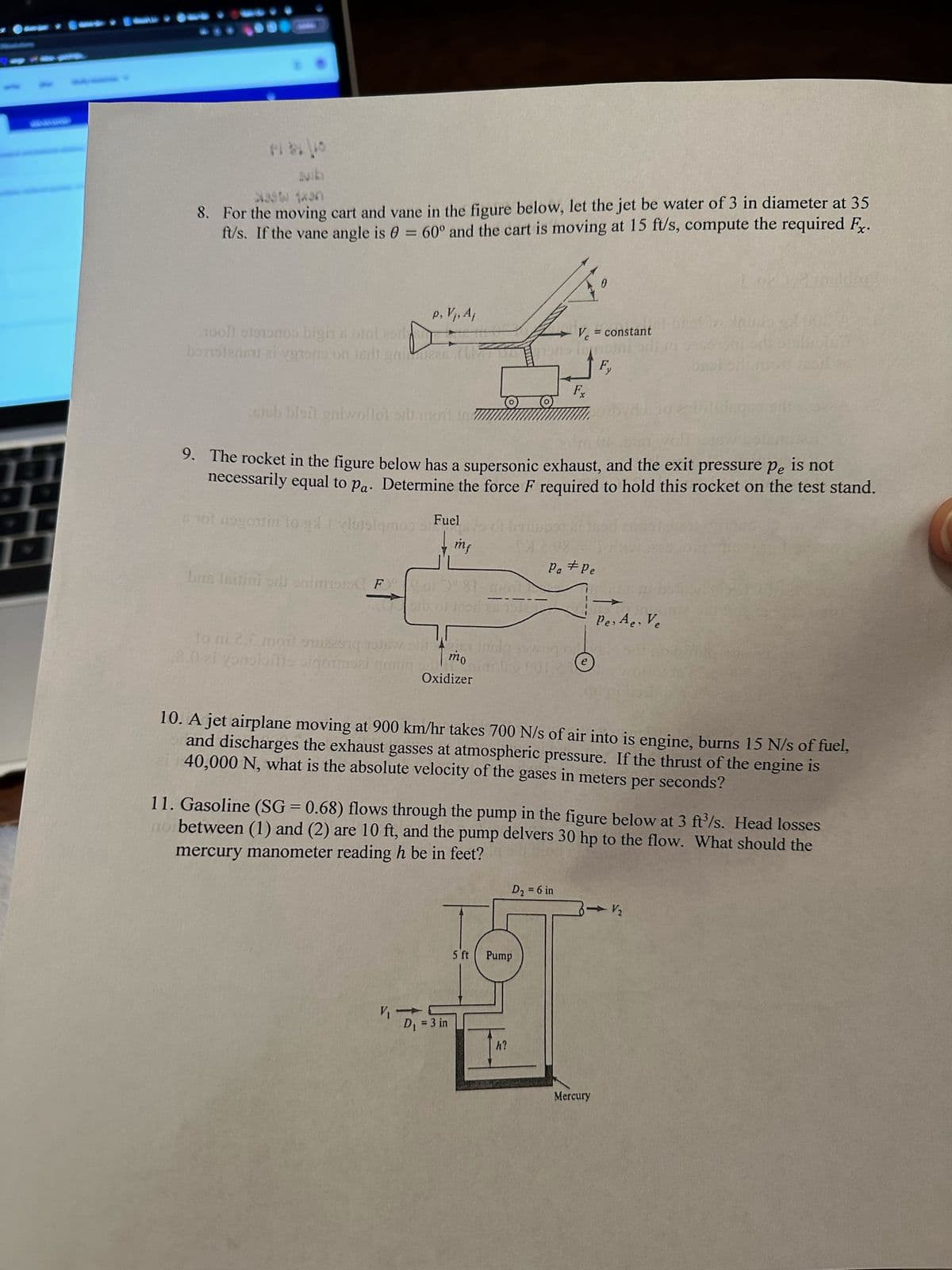A 200 kg chunk of lead falls from a height of 30 m and smashes into a rigid concrete floor. Calculate the increase in the internal energy AU (MJ), assuming that no energy is transferred as heat from the lead.
A 200 kg chunk of lead falls from a height of 30 m and smashes into a rigid concrete floor. Calculate the increase in the internal energy AU (MJ), assuming that no energy is transferred as heat from the lead.
Principles of Heat Transfer (Activate Learning with these NEW titles from Engineering!)
8th Edition
ISBN:9781305387102
Author:Kreith, Frank; Manglik, Raj M.
Publisher:Kreith, Frank; Manglik, Raj M.
Chapter6: Forced Convection Over Exterior Surfaces
Section: Chapter Questions
Problem 6.1DP
Related questions
Question

Transcribed Image Text:Problem Set No. 1
1. A 200 kg chunk of lead falls from a height of 30 m and smashes into a rigid concrete floor.
Calculate the increase in the internal energy AU (MJ), assuming that no energy is transferred
as heat from the lead.
2. Assess the capabilities of a hydroelectric power plant from the following field data:
Estimated water flow rate, 40 m³/s
River inlet at 1 atm, 10 °C
Discharge at 1 atm, 10.2 °C, 200 m below the intake
3. How much energy transfer as heat is required to evaporate completely 1 kg of nitrogen for a
constant pressure process, with T = 89.5 K?
4. One kg of CO₂ is heated in a 0.5 m³ vessel from -18 °C to 93 °C. Determine the initial and
final states, and the amount of energy transfer as heat to the CO2.
5. The condensate pump on the Navaho power plant raises the water pressure from 3.5 in of
mercury to 390 psia at a flow rate of 5,100 gal/min. If the pump isentropic efficiency is 0.8,
calculate the power required in hp.
6. Calculate the thermal efficiency of a simple Rankine cycle for which steam leaves the boiler
as a saturated vapor at 3x106 N/m² and is condensed to saturated liquid at 7,000 N/m². The
pump and turbine have isentropic efficiencies of 0.6 and 0.8, respectively. The pump inlet is
saturated liquid.
7. The water jet in the figure below strikes normal to a fixed plate. Neglect gravity and friction
and compute the force F required to hold the plate fixed in N.
D₁ = 10 cm
V₁ = 8 m/s
Plate
F
Catalog Dexemption Energy
dimensional gas dynamics. Airbreathing y
Introduction of thermochemistry and contraston Rocket fupe
Cheroical liquid and solid mes
Prerequisites EMAE 251 Thermodynamics and EMAE 359 A
Course Goals. The primary course goal is to introduce stude
propulsion. By utilizing their background in dynamics, ma
mechanics, students will be able to apply what was learn
an important field of practical application. Specific on
basics of propulsion principles. (2) developing metho
determining key elements and limitations of differen
appreciation for the future potential of an
Course Objectives: Upon completion of this co
1. An understanding of the essentials of diffe
characteristics, specific applications, and
2. An ability to perform cycle analyses o
3. An understanding of propulsion syste
An understanding of how rocket pe
inrity with chemical equi

Transcribed Image Text:131
X39W 1xan
8. For the moving cart and vane in the figure below, let the jet be water of 3 in diameter at 35
ft/s. If the vane angle is 0 = 60° and the cart is moving at 15 ft/s, compute the required Fx.
p, V₁, Aj
1001 5191000 bigin s otni esda
J Vc = constant
borstene ai vetons on her gnides (mans in di
Fy
bus Isitini sdi onimsis F
sisb bleit gniwollol orli m
9. The rocket in the figure below has a supersonic exhaust, and the exit pressure Pe is not
necessarily equal to pa. Determine the force F required to hold this rocket on the test stand.
101 nogomin to gylislamos
Fuel
94V
mf
V₁ →
or 3° 81-god
or of 1000 28 15122
01 bo
mo
Oxidizer
to ni 2.6 moi sing is wog g
8.0 ei yonoioille sigorski graug
niming 001 27
7
D₁ = 3 in
21
Fx
10. A jet airplane moving at 900 km/hr takes 700 N/s of air into is engine, burns 15 N/s of fuel,
and discharges the exhaust gasses at atmospheric pressure. If the thrust of the engine is
40,000 N, what is the absolute velocity of the gases in meters per seconds?
Pa #Pe
11. Gasoline (SG = 0.68) flows through the pump in the figure below at 3 ft³/s. Head losses
mercury manometer reading h be in feet?
no between (1) and (2) are 10 ft, and the pump delvers 30 hp to the flow. What should the
5 ft Pump
h?
D₂ = 6 in
0
Pes Ae. Ve
Mercury
V₂
Expert Solution
This question has been solved!
Explore an expertly crafted, step-by-step solution for a thorough understanding of key concepts.
This is a popular solution!
Trending now
This is a popular solution!
Step by step
Solved in 3 steps

Knowledge Booster
Learn more about
Need a deep-dive on the concept behind this application? Look no further. Learn more about this topic, mechanical-engineering and related others by exploring similar questions and additional content below.Recommended textbooks for you

Principles of Heat Transfer (Activate Learning wi…
Mechanical Engineering
ISBN:
9781305387102
Author:
Kreith, Frank; Manglik, Raj M.
Publisher:
Cengage Learning

Principles of Heat Transfer (Activate Learning wi…
Mechanical Engineering
ISBN:
9781305387102
Author:
Kreith, Frank; Manglik, Raj M.
Publisher:
Cengage Learning